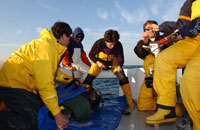



Another great day on the water. Not as much variety as yesterday as we didn't interact with turtles or little feathered friends, but we did have more tuna...which is nice. We ended the day with 6 bluefin tagged with archival tags and one with a conventional tag. The crew is really getting into the swing of things and the tagging process has been getting smoother nd smoother with each fish tagged. The weather looks a little rough for the next few days, so we may be off the water for a bit, but we'll be back and ready for action as soon as the weather clears. I realized that we didn't post any pictures of tuna yesterday, so everyone gets a double dose of tuna pictures today. Enjoy!




4 comments:
A couple of questions that I am having some trouble understanding:
1) it seems like you are seeing a ton of fish out there. If there are so many fish, why are they being listed on CITES?
2) And if you feel they should be listed on CITES, shouldn't you stop fishing for them? These fish die all of the time while being reeled in. Why take the risk with a fish you consider to be endangered?
Thanks for any insight.
Hi, and thanks for your interest. The good numbers of fish we are currently seeing off the coast of North Carolina come from one year class that is particularly strong. These fish are approximately 7 years old and we've been seeing them grow up for the past several years. Regarding the CITES listing, the criteria for listing have more to do with relative decline in population size than with the absolute number of fish left in the ocean. Although there may be 10's of thousands of bluefin tuna in the western Atlantic Ocean, that number is much smaller than how many used to be there before being overfished. The latest ICCAT assessment has shown a 90-95% decrease in the number of mature fish in the western Atlantic stock of bluefin tuna.
Regarding survivability after catch and release, we take all the precautions we can to ensure that the fish we catch and tag are stressed as little as possible. This includes using heavy fishing tackle to get them to the boat as fast as possible, using a padded mat on the deck and running a saltwater hose over the gills while we perform the surgery so that they stay aerated. Using pop-up tags, we have been able to test for post-release mortality. We would be able to tell if a fish died as the tag would report a constant depth (bottom) for an extended period before releasing from the fish and transmitting to satellites passing overhead. In the 12 years we have been tagging off the coast of North Carolina, we have never seen a fish die after release, even after deploying over 200 pop-up tags.
Thanks for the feedback. I find your work very interesting and important for the future of this fish. I am a recreational fisherman off of Cape Cod. I agree that one class of fish has been very impressive. Although this summer we did see huge amounts of smaller fish. It was the first year (out of the 5 that I have been fishing) that we saw a good mix of many different age classes, which is a great sign that the US and Canada's adherence to scientific advice is finally paying dividends. Hopefully those younger classes will one day be tag a giant candidates.
Regarding the success of your tagged fish, that is great news. I've always wondered about the survivability of the fish after release. However, I am assuming that since the tags are very expensive that you only tag the healthy fish. Have you ever brought a fish into the boat that due to the health of the fish was too risky to tag? I am assuming that over the years you have had some foul hooked fish or deep hooked fish - would you still tag those?
Thanks for the informative post and for actually replying to your readers’ comments. That’s something I don’t see very many blog owners doing and that makes me frustrated. Keep up the good work and I’ll continue coming back here to learn more....
Post a Comment